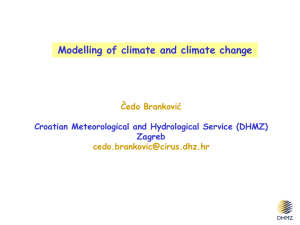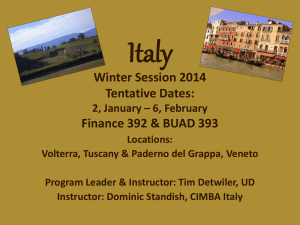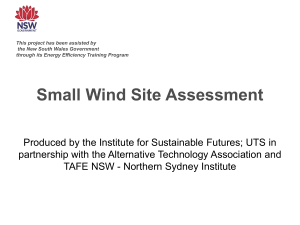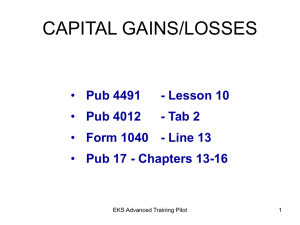Modelling - Engineering - University of Waterloo
advertisement
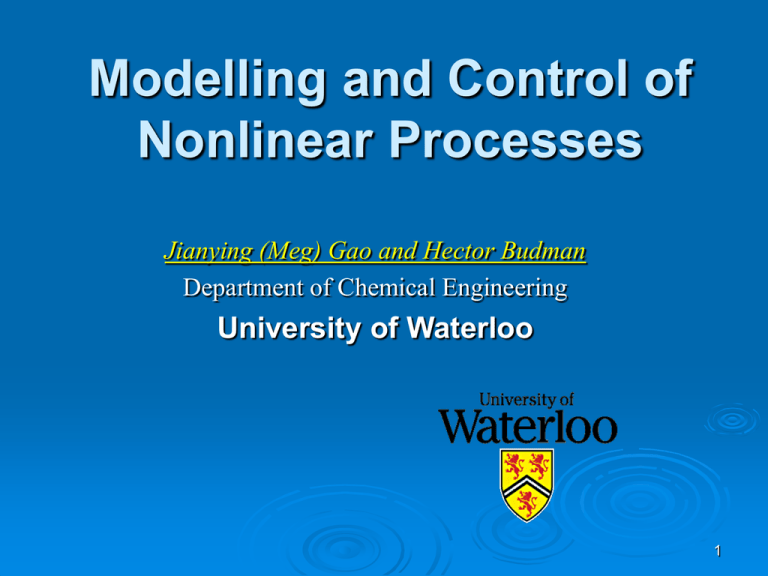
Modelling and Control of
Nonlinear Processes
Jianying (Meg) Gao and Hector Budman
Department of Chemical Engineering
University of Waterloo
1
Outline
Motivation
Modelling
•Volterra
series
•State-affine
PI
•RS&RP
Nonlinear process examples
Two major difficulties: modelling and control!
Empirical Modelling
Control
•G-S
Motivation
Volterra series, state-affine
Robust Control
Robust Stability (RS) and Robust Performance (RP)
Proportional-Integral (PI) control
Gain-scheduling PI (G-S PI)
Results and Conclusions
Continuous stirred tank reactor (CSTR)
Future application
2
Nonlinear Process Example 1
Motivation
Modelling
series
•State-affine
Fed-batch Bioreactor Mass Balance
Linear process: constant
dS
X
D( S i S )
dt
YX / S
•Volterra
Control
•G-S
PI
•RS&RP
Substrate
Si
Nonlinear process: Monod
Input
( S ) max
, X , S
S
Ks S
Output
dS
S
X
D( S i S ) max
dt
K s S YX / S
3
Nonlinear Process Example 2
Motivation
Continuous Stirred Tank Reactor: CSTR
Modelling
A
•Volterra
series
•State-affine
Control
•G-S
PI
•RS&RP
A B
Heat
1st order
Q f , C f ,T f
A&B
Cooling
u Tc
Input
Mass Balance:
Q f , C, T
V , ,T
Output
dC
V
Q f (C f C ) VkC
dt
k
Linear process: constant
Nonlinear process: Arrhenius
k (T ) e
E
RT
4
Nonlinear Control
Motivation
1st Difficulty: simple & accurate model
Modelling
•Volterra
series
•State-affine
Control
•G-S
PI
•RS&RP
Accurate: the model gives a good data fit
Simple: the model structure is simple to apply for
control purpose
2nd Difficulty: model is never perfect!
Uncertainty: model/plant mismatch
Controllers are desired to be ROBUST to model
uncertainty!
Robust control: takes into account uncertainty!
nonlinear
model
Linear
model
uncertainty
5
Empirical Modelling
Motivation
Type
First principles model
Empirical model
How?
Mass, energy balance
Input/output data
Choose?
Difficult, complex
Easy
Modelling
•Volterra
series
•State-affine
Control
•G-S
PI
•RS&RP
1g/l
model
y set e
-y
controller
u
process
(inlet
concentration)
v
y
measurement
1g/l
soft sensor
6
1st Order Volterra Series
Motivation
Modelling
series
•State-affine
No priori knowledge of the process is required!
Black box model between input and output
•Volterra
Control
•G-S
PI
•RS&RP
n
y (t ) hi u (t i )
i 1
h1u(t 1) h2 u(t 2)
S y(t )
u (t 2)
Si u
at different time
at current time
t-2 t-1 t
t
7
1st Order Volterra Series
Motivation
Tc
Modelling
•Volterra
series
•State-affine
Control
Impulse response
A
Q , C ,T
f
f
Cooling Tc
Input
0
1
•G-S
PI
•RS&RP
t
f
A&B
Q f , C, T
V , ,T
Output
C
t
u [1,0,0,0]
1
n
y [0, h1 , h2 ,hn ,0]
1st order Volterra kernels: h1 , h2 , hn
8
1st Order Volterra Series
C (1)
Tc (1)
Motivation
Modelling
•Volterra
series
•State-affine
=
Control
•Robust
control
•Gain-scheduling
•PI
•MPC
+
+
1
Tc ( 2)
2
1
C ( 2)
2
1
Tc (1) Tc (2)
2
Cooling
Temperature
=
n
y (t ) hi u (t i )
i 1
1
C (1) C (2)
2
Reactor
concentration
9
Volterra Series Model
Motivation
Modelling
•Volterra
series
•State-affine
Control
•G-S
PI
•RS&RP
No priori knowledge of the process is required!
Black box model between input and output
More terms, better data fit
n
n
n
y (t ) hi u (t i) hij u (t i )u (t j )
i 1
i 1 j 1
h1u(t 1) h2 u(t 2)
h11u(t 1)u(t 1) h12u(t 1)u(t 2)
2nd order Volterra kernels: h11 , h12 , hnn
10
Identify Volterra Kernels
Motivation
Modelling
Identification of Volterra kernels
u (t i) ui
•Volterra
series
•State-affine
y(t ) h1u1 h2 u 2 h11u1u1 h12u1u 2
Control
•G-S
PI
•RS&RP
w1 u1 , w2 u 2 , w3 u1u1 , w4 u1u 2
y(t ) h1 w1 h2 w2 h11w3 h12 w4
Linear least squares
11
Volterra Series Model
Motivation
Advantages
Modelling
•Volterra
series
•State-affine
Control
•G-S
PI
•RS&RP
From input/output data Tc C
Straightforward generalization of the linear system
description
Linear least squares algorithm: hi , hij
Disadvantages
The output depends on past inputs raised to different
powers and in different product combinations, e.g.
u(t 1) 2 , u(t 2)u(t 3), u(t 2) 3
Not suitable for robust control approach
Linear
model
uncertainty
12
State-affine Model
Motivation
Modelling
State-affine Model (Sontag, 1978)
•Volterra
series
•State-affine
Control
•G-S
PI
•RS&RP
I/O
Data
State-affine system, i.e. systems that are affine in the
state variables but are nonlinear with respect to the
inputs
It can cover a wide range of nonlinear processes
Identified from Volterra series model kernels
Suitable for robust control
Least
squares
Volterra
series model
Intermediate
step
Sontag’s
algorithm
State-affine
model
13
State-affine Model
Motivation
Model structure
x(t 1) F(u )x(t ) G (u )u (t )
Modelling
series
•State-affine
y (t ) h 0 x(t )
•Volterra
Where
Control
F(u ) F0 F1u (t ) F2 u (t ) 2
G (u ) G 1 G 2 u (t ) G 3u (t ) 2
•G-S
PI
•RS&RP
Identification of matrix coefficients Fi , G i , h 0
Iterative matrix manipulation of Volterra kernels
Sontag (1978), Budman and Knapp (2000,2001)
14
State-affine Model
Motivation
x(t 1) (F0 F1u (t )) x(t ) (G 1 G 2 u (t ) 2 )u (t )
Modelling
•Volterra
series
•State-affine
Control
PI
•RS&RP
A simple example
y(t ) h 0 x(t )
How to treat the nonlinearity as Uncertainty?
•G-S
Nominal point
Nonlinearity
x(t 1) F0 x(t ) G 1u (t ) F1u (t )x(t ) G 2 u (t ) 2 u (t )
y(t ) h 0 x(t )
1,t
Linear
model
uncertainty
2 ,t
15
Nonlinearity
Motivation
Modelling
Uncertainty is function of input: Key advantage!
i ,t u(t )i , 1,t u(t ), 2,t u(t ) 2
•Volterra
series
•State-affine
Control
Uncertainty
Uncertainty bounds
Tc 5 50( C )
•G-S
PI
•RS&RP
0
u(t ) 5 50
1,t 5 50
50
1,t
5
t
16
Results 1 (modelling)
Motivation
State-affine model
True process output
Modelling
•Volterra
series
•State-affine
0.3
Control
0.1
•G-S
PI
•RS&RP
0.2
0
-0.1
-0.2
-0.3
-0.4
-0.5
0
50
100
150
200
250
300
350
400
450
17
Results 1 (modelling)
Motivation
State-affine model
True process output
Modelling
•Volterra
series
•State-affine
0.3
Control
0.1
•G-S
PI
•RS&RP
0.2
0
-0.1
-0.2
-0.3
-0.4
-0.5
0
50
100
150
200
250
300
350
400
450
18
Results 1 (modelling)
Motivation
Modelling
•Volterra
series
•State-affine
Control
•G-S
PI
•RS&RP
State-affine model for CSTR
x(t 1) (F0 F1u (t )) x(t ) (G 1 G 2 u (t ))u (t )
y (t ) h 0 x(t )
0.1188 0.0345
F0
2
.
3416
0
.
0937
1
G1
0
0.1076 0
F1
1
.
2289
0
0
G2
1
h 0 0.1755 0.0382
19
Conclusions 1 (modelling)
Motivation
A general modelling approach is proposed!
Modelling
•Volterra
series
•State-affine
For a Nonlinear Process:
Obtained an empirical model from I/O data!
No priori knowledge required! So it can be applied to
processes with unknown dynamics!
Control
•G-S
PI
•RS&RP
Nonlinearity is dealt with as uncertainty!
Methods for quantifying the model uncertainty
from experimental data are studied.
x(t 1) (F0 F1u (t )) x(t ) (G 1 G 2 u (t ))u (t )
y (t ) h 0 x(t )
1,t
1,t
20
G-S PI Design
Motivation
PI controller:
Modelling
•Volterra
series
•State-affine
u (t ) K c [e(t )
Proportional gain: K 2
c
Integration time: 4 min
I
Control
e
•G-S
PI
•RS&RP
PI
1
0
t
1
I
t
e(i)]
i 1
Slope=
u
Kc
I
2
4
Kc 2
0
t
Gain-Scheduling PI controller
K c f (Tc )
I g (Tc )
u Si 5 50( 0C )
21
Traditional Gain-Scheduling
A
Motivation
Modelling
•Volterra
series
•State-affine
Control
•G-S
PI
•RS&RP
Tc 5 50( C )
0
5
Q f , C f ,T f
A&B
Q f , C, T
Tc
V , ,T
50
5 10
20 25
Linear
Model 1
Kc 2
I 4
45 50
Linear
Model 2
?
switch
Kc 3
I 3
Output
Linear
Model 3
?
switch
Kc 4
I 1.5
22
G-S PI Design
Motivation
Continuous G-S PI controller: state-space
1 t
u (t ) K c (u )[e(t )
e(i)]
I (u ) i 1
Modelling
•Volterra
series
•State-affine
Math manipulation
Control
(t 1) (t ) e(t )
•G-S
PI
•RS&RP
u Tc
e Cset C
u (t ) (C c Wc u (t )) (t ) ( Dc Wd u (t ))e(t )
Cc
Kc
I
, Dc K c
Design parameters:
Kc
I
K c , I ,Wc ,Wd
23
Closed-loop System: APS
Motivation
Modelling
η(t 1) A(δ t ) B(δ t ) η(t)
e(t) C(δ ) D(δ ) ν(t)
t
t
η(0) η0
•Volterra
series
•State-affine
Control
PI
•RS&RP
Affine Parameter-dependent System: the
closed-loop
•G-S
Assumption1:Affine dependence on the
uncertain parameters
A(δ t ) A 0 A1δ1,t A 2 δ2,t A n δn,t
δ t ( 1 , 2 ,, n ) R n
24
Uncertain Parameter
Motivation
Modelling
Assumption 2: Each uncertain parameter is
bounded [ , ]
i ,t
•Volterra
series
•State-affine
i
i
100
Tc 1,t
Control
•G-S
PI
•RS&RP
5
1
t
Convexity: Parameter vector
δ t is valued in a hyper-rectangle
called the parameter box
2
W
4
3
W : {(1 , 2 ,, n ) : i { i , i }}
25
Robust Stability
Motivation
Modelling
•Volterra
series
•State-affine
V
Lyapunov function
0
V 0
Energy
Stable position: zero energy
Path:
Control
•G-S
PI
•RS&RP
V 0
V 0
dV
0
dt
V 0
V 0
26
Robust Stability
Motivation
CSTR: avoid overheating, maintain target
Modelling
•Volterra
series
•State-affine
Max
S
Control
Min
•G-S
PI
•RS&RP
stable
1
W
4
2
3
unstable
General RS condition:
A( )T PA ( ) P 0, for all W
27
Robust Performance
Motivation
Modelling
•Volterra
series
•State-affine
Disturbance Rejection; performance index
Smaller , better performance
Larger , worse performance
e
Control
•G-S
PI
•RS&RP
v
e
L2
1
L2
=Disturbance in A
A&B
Q f , C, T
1g/l
(Cset C )
V , ,T
Output
28
Robust Performance
Motivation
Fed-batch bioreactor: product quality!
Modelling
•Volterra
series
•State-affine
Control
•G-S
PI
•RS&RP
Max
S
Min
Good
Bad
RP: Solve for and controller parameters
A( ) T PA ( ) P A( ) T PB CT
T
T
2
T
B PA ( )
B PB I D 0 for all W
C
D
I
29
Robust Control Design
Motivation
Modelling
•Volterra
series
•State-affine
Control
Empirical model of the
nonlinear process
•G-S
PI
•RS&RP
State-affine model
Controller structure
K c , I
PI:
G-S PI:
K c , I ,Wc ,Wd
Closed-loop system
RS and RP conditions are
checked
linear
model
uncertainty
controller
closed-loop
RS ?
RP ?
30
Results 2 (Linear PI)
Motivation
Linear PI: RS and RP regions
Modelling
20
•Volterra
18
series
•State-affine
Control
•G-S
PI
•RS&RP
16
I
Wc Wd 0
RS region
Good
14
12
RP region
10
8
6
4
2
0.5
1
1.5
2
2.5
3
3.5
Kc
31
Results 2 (G-S PI RS)
Motivation
Improve over linear PI Kc=2.42,taui=1.1545
Modelling
0.5
•Volterra
series
•State-affine
Good
Control
PI
•RS&RP
0
•G-S
Wc
-0.5
-1
-1
-0.5
0
Wd
0.5
1
1.5
32
Results 2 (G-S PI RP)
Motivation
Improve over linear PI Kc=2,taui=1.1545
Modelling
0.5
•Volterra
series
•State-affine
Good
Control
PI
•RS&RP
0
•G-S
Wc
-0.5
-1
-0.4
-0.2
0
0.2
0.4
0.6
0.8
1
1.2
Wd
33
Results 2 (PI)
Motivation
Simulation: G-S PI is much BETTER!
Modelling
•Volterra
series
•State-affine
Control
•G-S
PI
•RS&RP
1
Disturbance
0.5
0
-0.5
-1
0
2
4
6
8
10
12
14
16
18
20
1
Linear PI
0.5
0
G-S PI:better
-0.5
-1
2
4
6
8
10
12
14
16
18
20
34
Conclusions 2 (Control)
Motivation
Design and simulation results
Modelling
PI
•Volterra
series
•State-affine
Linear
Control
•G-S
PI
•RS&RP
G-S
I
Wc
Wd
2
1.15
0
0
0.96
0.38
1.37
2.95
-0.004
0.001
0.39
0.22
optimal simulation
is a good performance index
Kc
Consistence between analysis and simulation
A general robust design approach is proposed!
Based on empirical model from I/O data!
G-S PI! Much better performance for wide
operation range!
35
Conclusions
Motivation
Two difficulties are solved efficiently!
Modelling
•Volterra
series
•State-affine
Modelling: state-affine
Control: robust control
Control
•G-S
PI
•RS&RP
Our contributions!
Quantify uncertainty from I/O data!
Develop global RP conditions!
Propose Continuous G-S PI structure!
36
Application
Motivation
Modelling
Empirical Modelling
•Volterra
series
•State-affine
Control
•G-S
PI
•RS&RP
Models:
nonlinear
biochemical processes
chemical
and
Robust Control Design
Nonlinear processes when nonlinearity is
treated as uncertainty!
Uncertain processes with real and timevarying uncertainty!
37
Motivation
Modelling
•Volterra
series
•State-affine
Control
•G-S
PI
•RS&RP
38
Unconstrained MPC
K+m
p: prediction horizon;m: control horizon
k: sampling point, same as t
Unconstrained MPC
Quadratic Design Objective
2
1
2
ˆ
min { Γ[Y(k 1 / k ) R (k 1)] ΛU }
[1]
u ( k ) 2
ˆ (k 1 / k ) M Y
ˆ (k ) W(k 1 / k ) S u U(k )
s.t. Y
p
p
Solution
0
0
Γε ( k 1 / k )
ΓS u
[2]
U(k )
0
Λ
ε(t 1 / k ) R(k 1 / k ) M p Y(k ) W(k 1 / k )
Unconstrained MPC
Least Squares Solution
x (A T A) 1 A Tb
Ax b
MPC Solution: Best Sequence of m Control Moves
uT
p
1
uT
p
U(k ) (S Γ ΓS Λ Λ) S Γ Γε(k 1 / k )
T
u
p
T
T
Present Control Move is Implemented
u (k ) K MPCε(k 1 / k )
K MPC 1 0 01m (S Γ ΓS Λ Λ) S ΓT Γ
uT
p
T
u
p
T
1
uT
p
MPC Design Parameters
No general guide on design parameters!
Control horizon: m
Small: a robust controller that is relatively insensitive to model
errors
Large: computational effort increases; excessive control action
Prediction horizon: p
Large: more conservative control action which has a stabilizing
effect but also increase the computational effort
weighting matrix for outputs :
Usually set
Γ const
Γ
State-space MPC
Weighting matrix for inputs:
Λ I
More important than other parameters
Small
Large
Λ
Λ
more aggressive control, less stable
less aggressive control, more stable
State-space MPC (Zanovello and Budman,1999)
U(k ) E2 T1K mpcN 2 U(k 1)
u(k ) C
K
N
y
(
k
)
mpc 2
u1
Closed-loop System: APS
Robust G-S MPC
Operation Range
Step 1
1(u=-1)
Step 2
1 1 0
Step 3
1 {1,0}
Step 4
2(u=0)
1
u [1,1]
2
State
Affine 1&2
State
Affine 2&3
MPC 1-2
MPC 2-3
Switching
3(u=1)
1 0 1
1 {0,1}
RS
&
RP
Outline
Traditional G-S Design
Design procedure and disadvantages
Robust G-S Design
Affine parameter-dependent systems (APS)
RS and its LMI formulation
RP and its LMI formulation
Robust G-S MPC design
State-affine model and uncertainty quantification
State-space formulation of MPC
Results and Conclusions
Case study: nonlinear CSTR
Nonlinear CSTR
Pure A
Q f , C f ,T f
Mix of A and B
V , ,T
u(t)=Tc
1st –order exothermal reaction
Q f , C ,T
Results (1)
Optimization Design Results: Table 1
# of ranges
u [1,1]
k 5
k4
k 3
k2
k 1
[0.2033,0.7817,0.9618,1.4984,1.0681]
[0.1909,0.7518,1.0746,1.6372]
0.5044
0.4440
[0.3521,0.2013,1.2408]
0.4729
[0.1121,1.7121]
0.4210
[1.1650]
0.4461
Evenly Separated Ranges
Conclusions (1)
Efficient Robust G-S MPC Design
Simulation test with disturbances, e.g. IMA, and etc.
Global G-S MPC designed with guaranteed RS and RP
Analysis is the worst case which covers all the simulations
Observations of the Robust G-S MPC Design
Performance index close to each other
Even separations may not capture the process nonlinearity
Conservatism of the design
Robust G-S MPC Performance depends on
# of separations
Separation point locations: evenly or not
Nonlinear dynamics
Results (2)
Comparison of two controllers: Analysis & Simulation
G-S MPC 5-1:
G-S MPC 5-2:
Λ
Λ
designed based on optimization
chosen randomly
Table 2
optmization
Yes
No
( k 5 , u [1,1] )
[0.2033,0.7817,0.9618,1.4984,1.0681]
[10,10,10,10,10]
simulation
0.5044
0.7230
0.2115
0.3144
Results (2)
CSTR Simulation: Figure 1
G-S MPC output and disturbance
1
0.8
Disturbance
0.6
0.4
No optimization
0.2
0
-0.2
Optmization
-0.4
-0.6
-0.8
-1
0
5
10
15
20
25
30
35
40
45
50
Conclusions (2)
is a Good performance index
Consistence between analysis and simulation (Table 2)
Robust G-S MPC Design
Global G-S MPC designed with guaranteed RS and RP
Analysis is the worst case
Future Directions
Separation of operation range, # of separations
Reducing conservatism of the design
Process with more nonlinearity
Traditional G-S Design
A typical G-S design procedure for nonlinear plants
Step1: select n operating points which cover the range of the
plant’s dynamics
Step 2: Linearize a first principle model or identify linear models
around each operating point
Step 3: Design local linear controller for each local linear model
Step 4: In between operating points, the gains of the local
controllers are interpolated, or scheduled, resulting in a global
controller.


